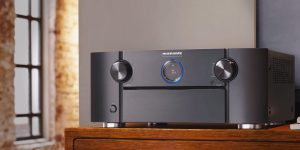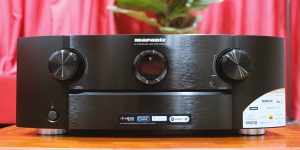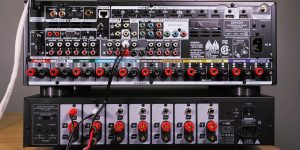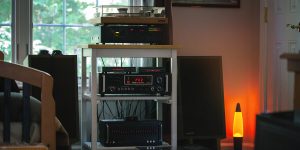When it comes to home audio and video equipment, an AV receiver is the foundation of any setup. It’s the piece of technology that connects all your devices and speakers, amplifies your audio signals, and processes your video signals. But with so many options on the market, finding the best AV receiver under $500 can be a daunting task. Fear not, I have done the research for you and compiled a list of top picks that won’t break the bank.
Here, in addition to providing a curated list of receivers, I will also guide you through the most important criteria to consider when shopping for one and provide setup and troubleshooting tips. So, whether you’re a music lover, gamer, or home theater enthusiast, read on to find the right AV receiver under $500 for your needs.
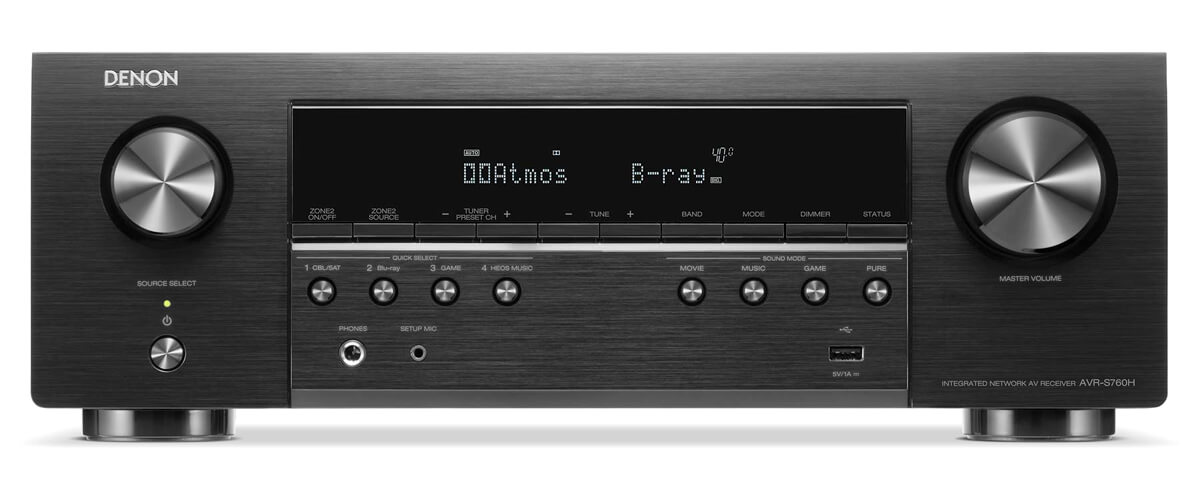
AV receiver under $500 comparison table
| Name | Channels | Power output | HDMI in/out | Bluetooth/Wi-Fi | Review |
|---|---|---|---|---|---|
| Denon AVR-S760H best overall | 7.2 | 75W/8 Ohms, 110W/6 Ohms | 6/1 | yes/yes | Review |
| Yamaha RX-V4A also a great choice | 5.2 | 60W/6 Ohms | 4/1 | yes/yes | Review |
| Onkyo TX-8220 stereo receiver | 5.1 | 70W/8 Ohms | 4/1 | yes/no | Review |
Key features to consider when choosing the best AV receiver for under $500
In this section, we’ll cover the essential features to look for in audio receivers that will help narrow down your options.
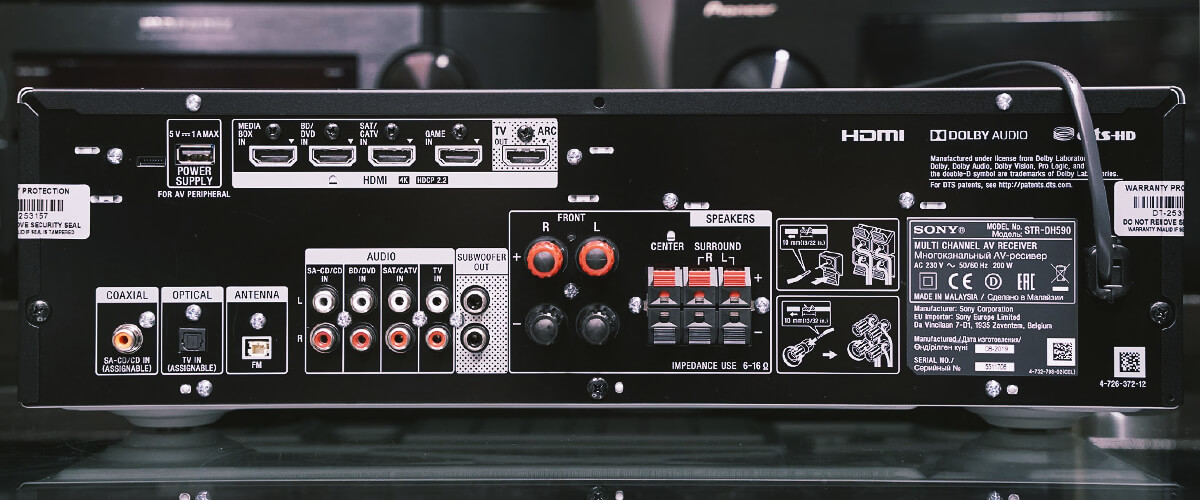
Channel support
One of the most critical considerations when choosing an AV receiver is the number of channels it can support. You have several options in this price range, including 5.1, 7.1, and 7.2-channel configurations. Additionally, many modern models support object-based surround sound formats like Dolby Atmos or DTS:X. Choose a unit that supports these formats if you’re interested in enhancing your audio setup. However, keep in mind that more channels and object-based formats may require additional speakers, which can increase the overall cost of your setup. Therefore, do consider your budget and space limitations before deciding on the number of channels and configurations you want to support.
Audio and video processing
It’s also important to take into account the receiver’s audio and video processing capabilities. For an immersive viewing experience, look for a device that supports 4K video and HDR formats, which provide high-quality visuals with a wide range of color and contrast. Additionally, you may also appreciate high-quality audio codecs like Dolby TrueHD and DTS-HD Master Audio. They offer a lossless audio experience, meaning you can enjoy the original, uncompressed audio as intended. Having advanced audio and video processing capabilities in your receiver can greatly improve your overall entertainment experience, allowing you to enjoy your favorite movies, TV shows, and music in high quality and with crystal-clear sound.
Network streaming
If you want to stream audio from online services like Spotify or Pandora, choose a unit with network streaming support. This feature allows you to access and play music directly from the receiver without the need for a separate gadget like a smartphone or tablet. Network streaming can provide a more seamless and convenient music-listening experience, especially if you often use streaming services. Just make sure to check for compatibility with your preferred platforms before making your purchase.
Pick an AVR according to the specific use cases
Not all AVRs are created equal. In this section, I’ll cover the specific use cases for receivers, so you can choose the one that fits your needs.

Gaming
If you want to use your AV receiver for gaming, pick a model that can provide you with a smooth and responsive gaming experience. To achieve this, look for a receiver with low input lag, which can help minimize the delay between the time a signal is sent and when it’s displayed on your screen. This can be especially important for fast-paced games like first-person shooters or racing games, where even a slight delay can impact your performance. Additionally, search for a receiver that supports the latest gaming technologies, like Variable Refresh Rate (VRR), Auto Low Latency Mode (ALLM), and Quick Frame Transport (QFT). These features can help reduce screen tearing, provide a more stable frame rate, and improve the overall responsiveness of your gaming experience, ensuring that you can immerse yourself fully in your favorite games without any distractions.
Home theater
If you’re setting up a home theater system, you’ll want an AV receiver that can deliver an immersive audio and visual experience. Look for a model that supports object-based surround sound formats like Dolby Atmos and DTS:X. Additionally, choose a unit that has advanced video processing capabilities like 4K/60Hz video, HDR, and HDCP 2.2 copy protection. This results in sharper, more vivid, and color-accurate visuals with a higher dynamic range. Also, a home theater receiver should have a variety of HDMI inputs to accommodate multiple video sources.
Music playback
Planning to use your AV receiver mainly for music playback? You’ll need a device with advanced digital-to-analog converters (DACs) that can convert digital signals to analog ones with minimal distortion, ensuring that the music sounds clear and crisp. Additionally, your receiver should support high-resolution audio formats such as FLAC and DSD, which offer a more detailed and nuanced listening experience. Besides, network streaming capabilities are also a huge “plus” – they allow you to access and play music directly from popular online services.
Top picks for best AV receiver under $500
Denon AVR-S760H – best overall

Denon AVR-S760H is a 75W/Ch receiver that brings the magic of immersive audio and cutting-edge visuals to your home theater at a more than reasonable price. With 8K video support, advanced gaming features, and seamless multi-room audio, this marvel offers a great entertainment experience, considering it’s a mid-range model.
Imagine watching the latest action blockbuster with the AVR-S760H’s Dolby Atmos Height Virtualization and DTS:X capabilities, engulfing you in a three-dimensional soundscape. The sound is further enhanced by the receiver’s 7.2 channel configuration, filling the room with lifelike audio that transports you right into the heart of the action.

As a gaming aficionado, you’ll love this unit’s Variable Refresh Rate (VRR), Quick Frame Transport (QFT), and Auto Low Latency Mode (ALLM) features. These technologies minimize lag and frame tearing, resulting in a buttery smooth gaming experience that pairs great visuals with high-resolution sound effects. No more distractions or delays – just pure, unadulterated gameplay.
The receiver is really versatile with its AirPlay, Wi-Fi, and Bluetooth features. Moreover, it delivers multi-room audio. Thanks to its HEOS wireless speaker support, your favorite tunes can effortlessly fill every room in your home. Stream your go-to playlists from Pandora, Spotify, or Deezer, and control the music hands-free with Alexa or other major voice assistants.
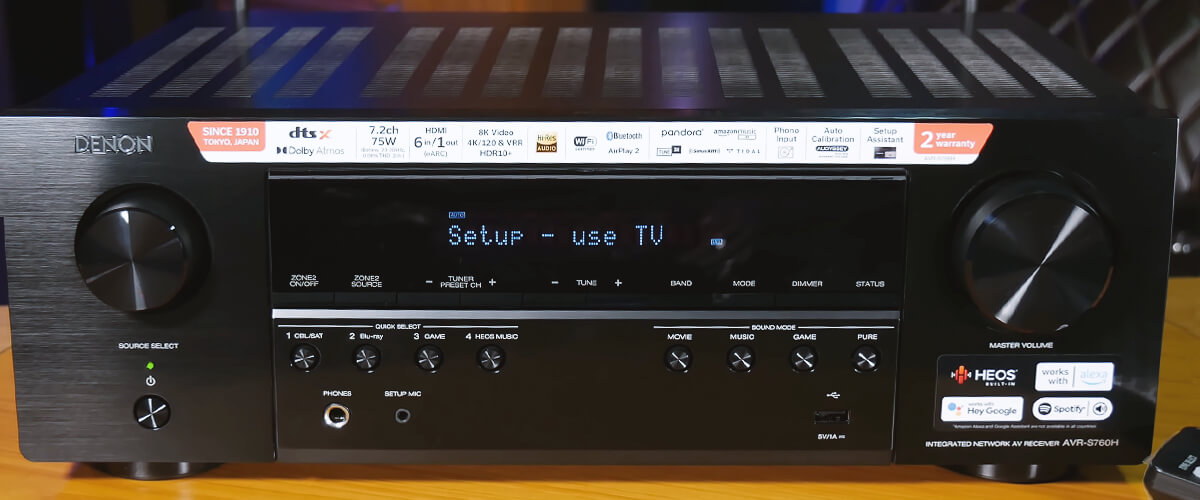
While the receiver’s 6 HDMI inputs offer plenty of connectivity options, some users might find the single HDMI output limiting. However, with the eARC feature, you can connect an eARC-enabled TV to enjoy high-quality audio from multiple sources without the need for additional cables.
Denon AVR-S760H is the right pick for those seeking the best home theater receiver under 500 dollars. For a mid-range model, it boasts advanced features, outstanding sound quality, and seamless integration with your entertainment ecosystem making it the ultimate choice for elevating your home theater experience. Worth every single penny!
Specifications of Denon AVR-S760H
- Channels: 7.2.
- Output power: 75W/8 Ohms, 110W/6 Ohms.
- HDMI inputs/outputs: 6/1.
- Surround sound
- Dolby features: Dolby TrueHD, Dolby Atmos Height Virtualizer, Dolby Atmos, Dolby Surround.
- DTS features: DTS HD Master, DTS:X, DTS Neural:X, DTS Virtual:X.
- Video
- Video functions: 4K/120Hz, 8K/60Hz pass-through, upscaling to 8K.
- Video support: HDMI ARC, HDMI eARC, HDMI CEC, HDCP2.3, HLG, HDR10, HDR10+, Dynamic HDR, Dolby Vision.
- Bluetooth/Wi-Fi: yes/yes.
- Streaming service: AirPlay2, Spotify, Deezer, Tidal, Pandora, SiriusXM, Napster, SoundCloud, Amazon Music HD, TuneIn.
Pros
- Versatile – handles multiple inputs.
- Hassle-free setup routine.
- Good surround sound that fills the mid-size room.
- Support for 4K/8K video.
- Rare features for a receiver of this class.
Cons
- A bit tricky mode switching.
Yamaha RX-V4A – also a great choice

Looking for a good 4K receiver for under five hundred dollars? You may end your search here! Yamaha RX-V4A has got you covered. This stylish 5.1-channel unit packs a powerful punch in both audio and visual performance. With 8K video support, high-quality audio processing, and versatile streaming options, it is a perfect centerpiece for any modern home theater setup.
Dive into a world of crystal-clear audio with the RX-V4A’s Dolby Atmos and DTS:X capabilities. From the softest whispers to the most earth-shattering explosions, the RX-V4A captures every nuance with precision.

The receiver’s 4 HDMI 2.1 inputs ensure your home theater is future-proof, supporting 8K video as well as 4K at 120Hz. Enjoy stunning visuals with Dolby Vision, Hybrid-Log Gamma, and BT.2020, ensuring your movie nights and gaming sessions are nothing short of breathtaking.
For music lovers, this sleek device offers a plethora of streaming options, including Wi-Fi, AirPlay 2, MusicPlay, and Spotify Connect. Voice control with Alexa, Google Assistant, or Siri via AirPlay 2 adds an extra layer of convenience, allowing you to control your tunes without lifting a finger.
The YPAO room calibration feature ensures that your audio is optimized for your specific listening environment. However, some users may find the calibration process slightly challenging. To overcome this, I recommend following the user manual closely and seeking online resources or tutorials if needed.
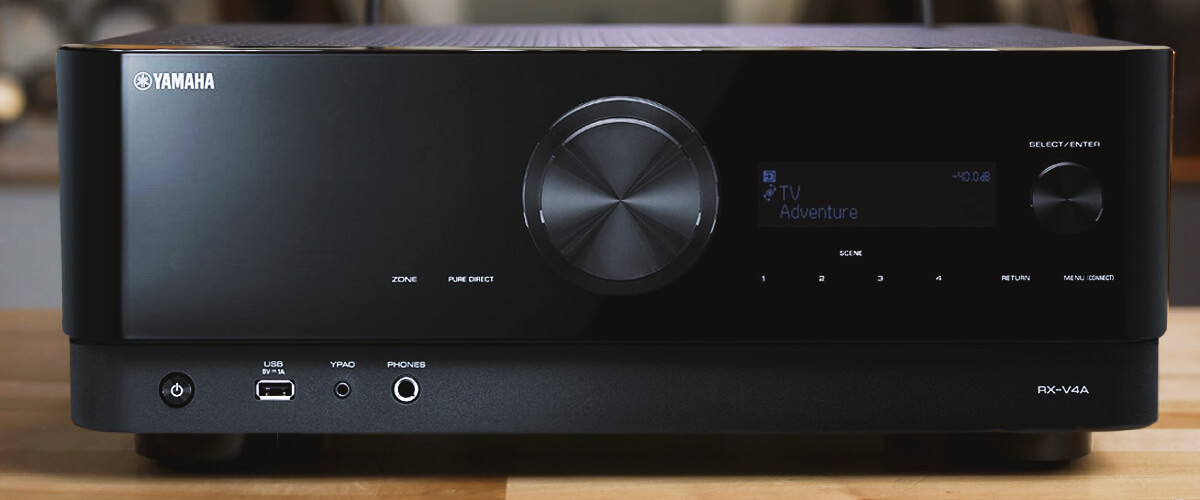
As you can notice, Yamaha RX-V4A and our winner Denon AVR-S760H sit in the same price region and have similar characteristics. However, the latter has additional HDMI inputs and a wider variety of input options, making it more versatile for connecting various audio sources. Plus, the RX-V4A features a 5.1-channel configuration, while the AVR-S760H boasts a more sophisticated 7.2-channel system. But on the other hand, if you have a small or medium-sized room, Yamaha delivers more than enough power and sound. Plus, you can always pair the receiver with additional speakers or upgrade to a 7.2-channel system if you move to a larger space or want a more immersive experience.
Yamaha RX-V4A offers a blend of sleek design, a host of great features, and uncompromising performance, making it the best 5.1 receiver under 500. Whether you’re a movie buff, a dedicated gamer, or a music fan, this receiver has something for everyone. So sit back, relax, and let it transport you into the world of your favorite entertainment.
Specifications of Yamaha RX-V4A
- Channels: 5.2.
- Output power: 80W/6 Ohms.
- HDMI inputs/outputs: 4/1.
- Surround sound
- Dolby features: Dolby TrueHD, Dolby Digital Plus.
- DTS features: DTS HD Master.
- Video
- Video functions: 4K/120Hz, 8K/60Hz pass-through, upscaling to 4K.
- Video support: HDMI ARC, HDMI eARC, HDMI CEC, HDCP2.3, HLG, HDR10, HDR10+, Dolby Vision.
- Bluetooth/Wi-Fi: yes/yes.
- Streaming service: AirPlay2, Spotify, Deezer, Tidal, Pandora, SiriusXM, Napster, SoundCloud, Amazon Music HD, TuneIn.
Pros
- Stylish design.
- Support for 4K and 8K video.
- Looks nice and sounds even better.
- Easy to get up and running.
- Good remote.
Cons
- Small but manageable display.
- No 7-speaker surround.
- Over HDMI, the interface may have a slight delay.
Onkyo TX-8220 – stereo receiver
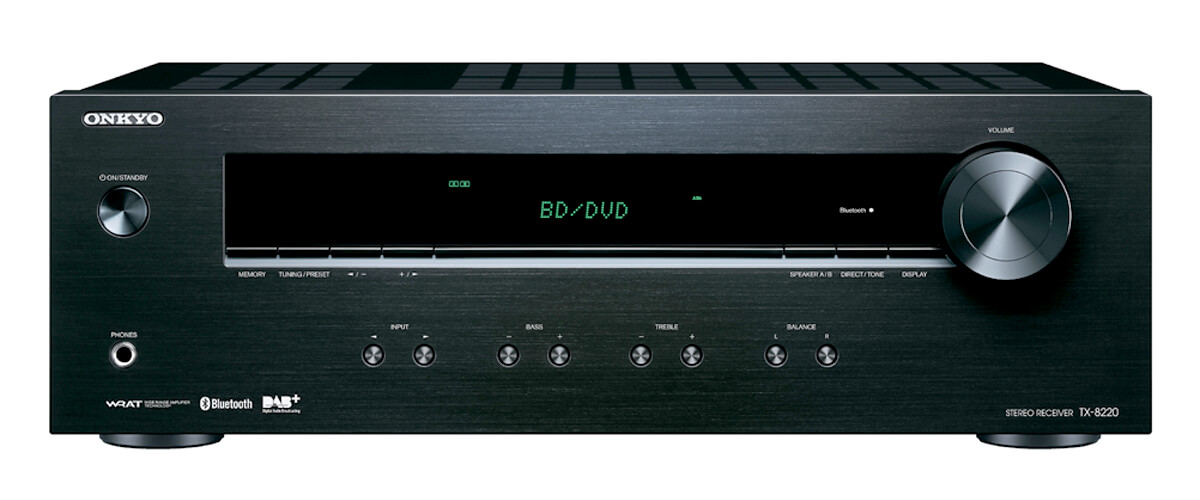
Onkyo TX-8220 is a vanishing breed of low-cost but high-quality stereo equipment that is on the point of extinction.
What I like the most about the TX-8220 is its ability to power two sets of speakers simultaneously, allowing you to enjoy your favorite tunes in two separate rooms. For example, you could be playing music in your living room while your partner listens to a podcast in the bedroom, all controlled through the same device. If you prefer, you can also switch between two sets of speakers, giving you the flexibility to cater to your specific preferences.
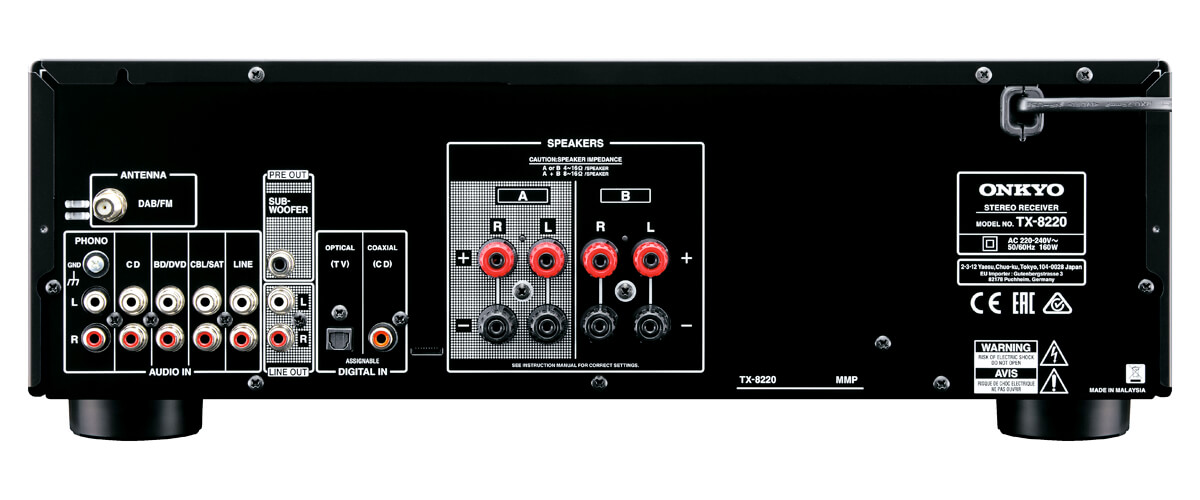
This model also brings the convenience of Bluetooth technology to the table. The receiver remembers your device for easy, automatic playback, eliminating the need to fuss with cables or manual connections.
Thanks to the diverse range of connection options, the TX-8220 caters to both film and music lovers. So whether you’re a vinyl enthusiast seeking a quality MM phono stage for your turntable or a movie buff who wants crystal-clear sound for your TV, this receiver has you covered. Four analog line inputs ensure that you have plenty of options for connecting additional audio sources.
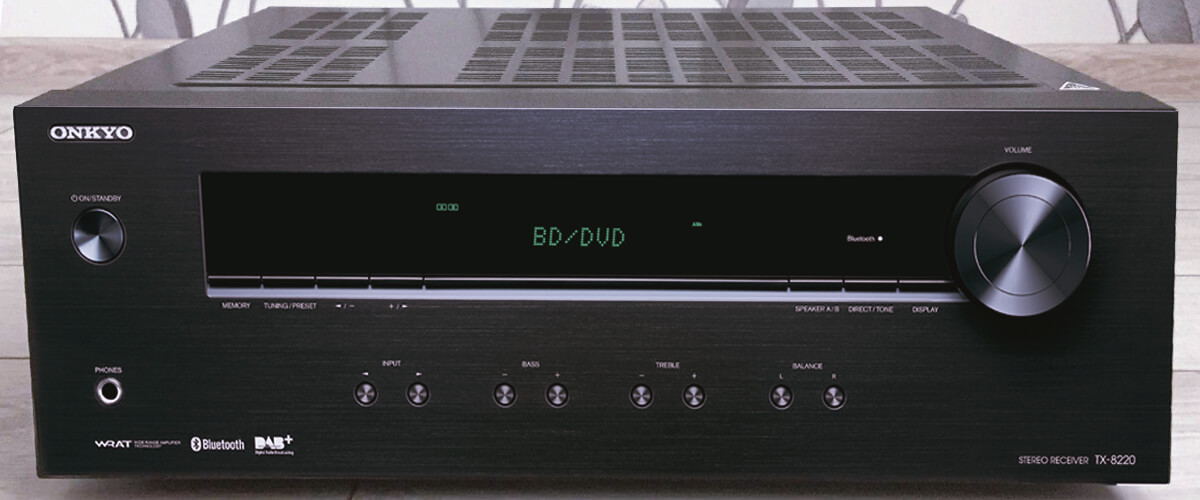
At the heart of the TX-8220’s audio performance lies Onkyo’s Wide Range Amplification Technology (WRAT). This technology features a high-current, low-impedance approach, employing a sizable EI transformer to deliver precise and robust sound to your speakers, even when faced with challenging conditions. Therefore, the audio output remains consistently high-quality, ensuring an enjoyable listening experience.
While this AVR is an excellent all-around performer, it might not be the ideal choice for those seeking advanced features like multi-channel surround sound or built-in Wi-Fi. At the same time, you can always explore third-party accessories or upgrade to a higher-end model within the Onkyo lineup if you need additional functionality.
Fans love Onkyo for delivering excellent audio quality at an affordable price point. With its well-thought design and versatile features, it’s the best stereo receiver for under 500 dollars. Get it while you can!
Specifications of Onkyo TX-8220
- Channels: 2.1.
- Output power: 45W/8 Ohms, 100W/6 Ohms.
- HDMI inputs/outputs: 0/0.
- Surround sound: has not.
- Video: has not.
- Bluetooth/Wi-Fi: yes/no.
- Streaming service: has not.
Pros
- Good build quality.
- First-rate sound quality.
- Optimal quality-price ratio.
Cons
- Not so many connections.
- May need to invest in banana plugs.
Sony STRDH590
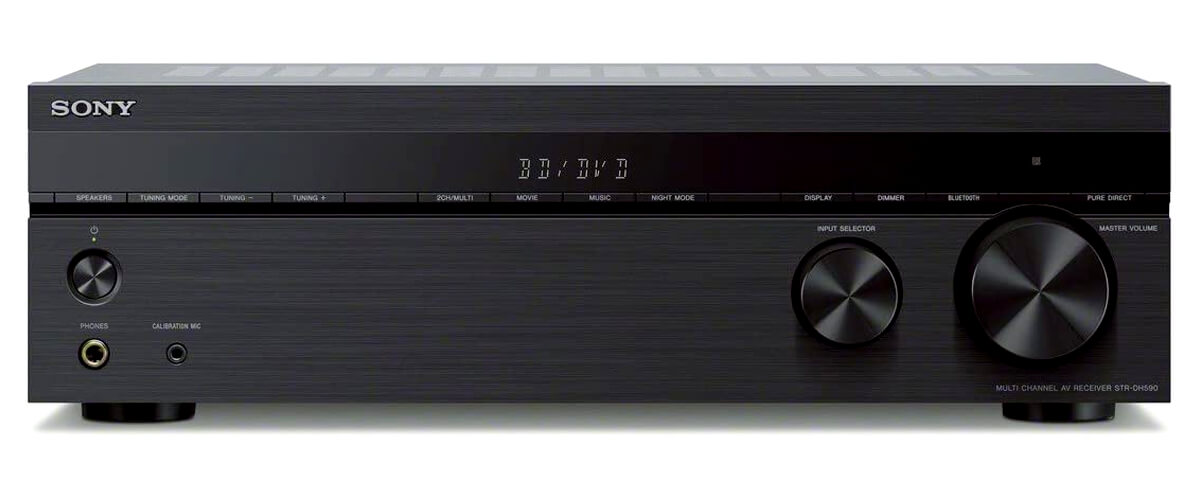
Imagine enjoying your favorite movie or TV show with a more immersive audio atmosphere. The 5.2-channel Sony STRD-H590 receiver makes this possible with its S Force PRO technology, which skillfully creates virtual surround sound using just a two-speaker setup. This means that even with limited space or budget constraints, you can still appreciate an engaging audio environment that adds depth to your media.
With Bluetooth support, you can easily stream music from your phone or other devices, adding a layer of convenience to your audio setup. The Bluetooth Standby function even allows you to turn on the receiver remotely, so you can start enjoying your favorite tunes without leaving the comfort of your couch.
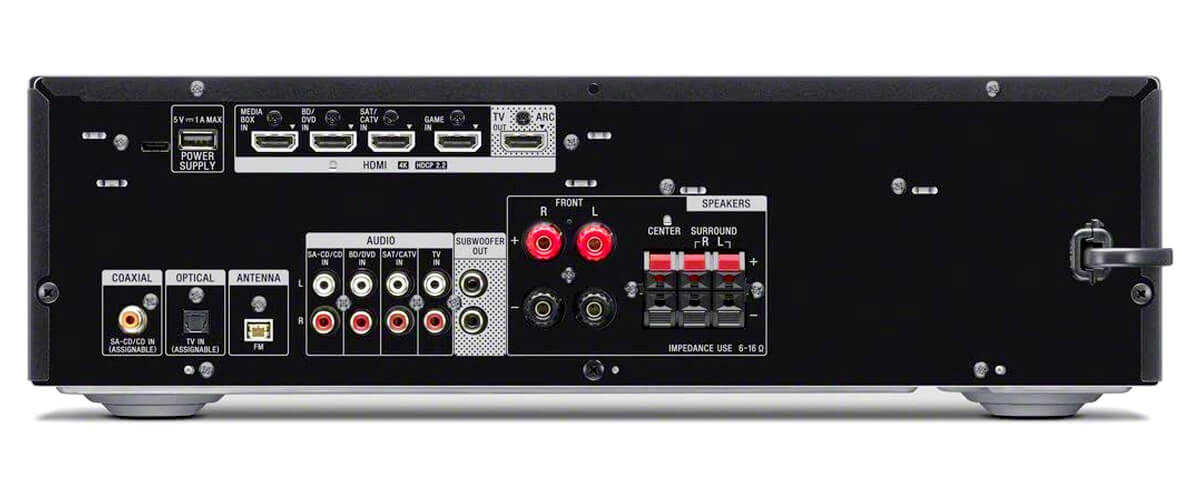
The multi-function system is another aspect that sets the Sony STR-DH590 apart. It offers a multi-channel stereo setup, an FM radio tuner, and a 1/4-inch headphone jack for a more personalized audio experience. Whether you’re in the mood for some late-night music or catching up on the latest news, you will have it all with the STR-DH590.
In terms of connections, this unit provides a decent array of inputs and outputs. With four stereo RCA audio inputs and two digital audio outputs (one optical and one coaxial), you’ll be able to connect a variety of devices with ease. It also includes four HDMI inputs and one output with Audio Return Channel support for smooth integration into your home theater setup.

While the STR-DH590 offers many advantages, there may be some limitations due to its mid-priced nature. For example, the S Force PRO technology may not provide the same level of immersion as a full surround sound speaker system. However, considering the price and space-saving benefits, it still delivers a commendable audio performance.
If you need a solid mid-priced surround sound receiver that offers a fantastic balance of good sound, user-friendly features, and effortless connectivity, all at a wallet-friendly price, Sony STR-DH590 may be the right pick for you.
Specifications of Sony STRDH590
- Channels: 5.2.
- Output power: 80W/6 Ohms.
- HDMI inputs/outputs: 4/1.
- Surround sound
- Dolby features: DSD, Dolby TrueHD, Dolby Digital, Dolby Dual Mono.
- DTS features: DTS HD Master.
- Video
- Video functions: 4K60Hz pass-through.
- Video support: HDMI ARC, HDMI CEC, HDCP2.2, HLG, HDR10, Dolby Vision.
- Bluetooth/Wi-Fi: yes/no.
- Streaming service: has not.
Pros
- Decent sound for both TV and music.
- Gets pretty loud, high-quality sound.
- Straightforward setup.
- Easy to operate.
Cons
- Bass treble tuning is available only through an onscreen TV adjustment, which is a bit inconvenient.
Pioneer VSX-834
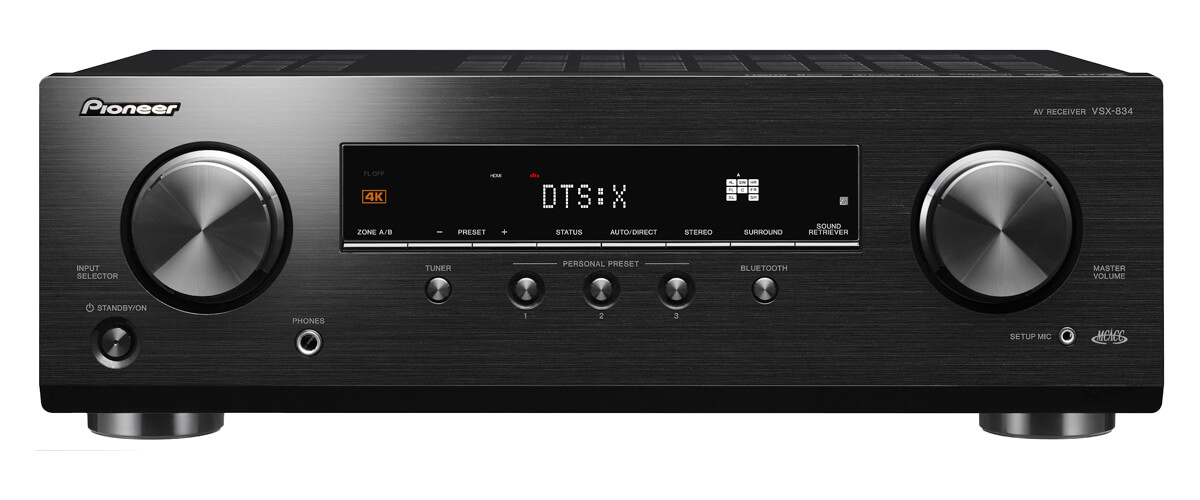
The Pioneer VSX-834, a remarkable entry-level 7.2 receiver, delivers top-notch audiovisual performance at a price that won’t break the bank. Boasting Dolby Atmos and DTS:X audio technologies, it is poised to captivate home theater fans with its rich, immersive soundscapes.
Notably, the VSX-834 incorporates Dolby Atmos Height Virtualization and DTS Virtual:X, ingeniously simulating a surround-sound environment without the need for height or additional speakers. I tested this unit with the Midway film, and the planes seemed to fly all over my room.
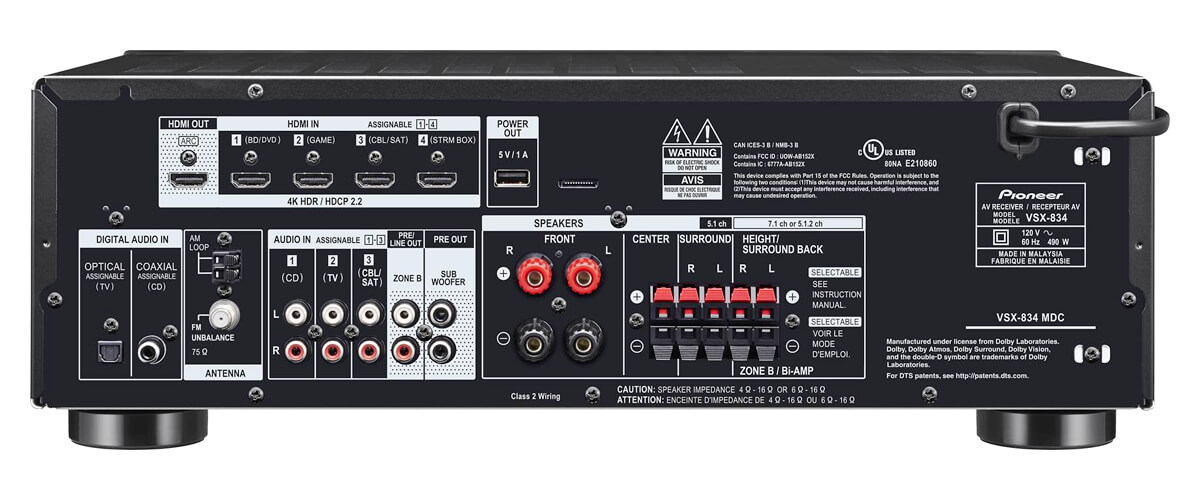
The receiver supports the latest video standards, including Ultra HD, HDR10, HLG, and Dolby Vision, and with HDCP 2.2, you can enjoy your favorite 4K HDR content without any issues.
I love this model’s Zone B technology, which allows you to enjoy music playing in the Main Zone via wireless headphones. If you want to enjoy your tunes without disturbing others in the room, you’ll appreciate this feature too.
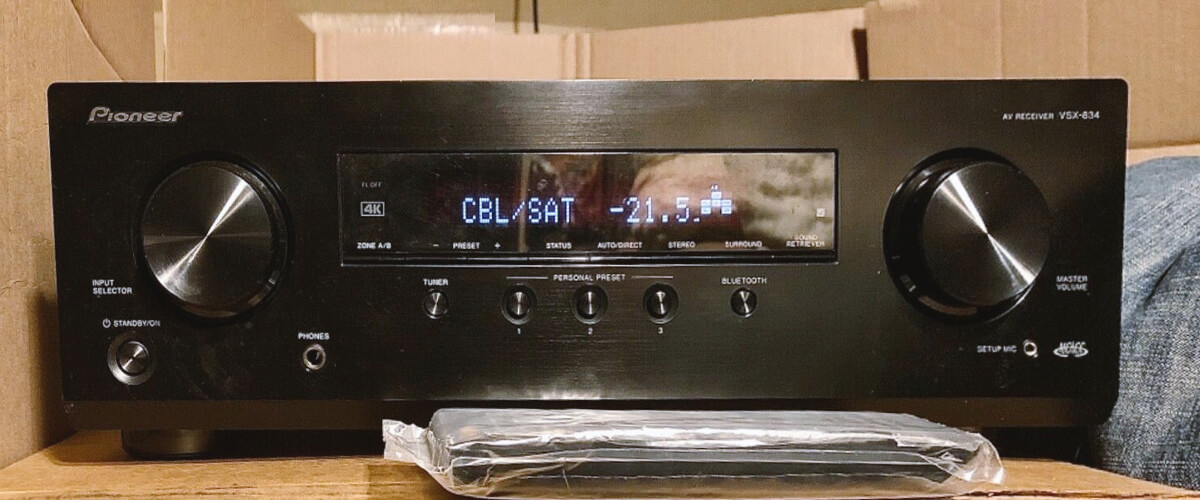
Pioneer has never disappointed me with the sound quality, and this receiver is no exception. You can listen to your highly compressed MP3 and WMA files stored on your gadgets with the same level of detail, warmth, and clarity that the composer intended. By retrieving information that is typically lost during digital compression, Pioneer’s Advanced Sound Retriever Technology improves audio playback up to 20 kilohertz.
In terms of value, Pioneer VSX-834 is hard to beat. It is well-equipped with ports, generates high-quality sound & video, and comes with convenient features. Great 7.2 receiver for less than $500!
Specifications of Yamaha RX-V4A
- Channels: 7.2.
- Output power: 80W/8 Ohms.
- HDMI inputs/outputs: 4/1.
- Surround sound
- Dolby features: Dolby TrueHD, Dolby Atmos, Dolby Digital Plus, Dolby Atmos Height Virtualizer.
- DTS features: DTS HD Master, DTS:X, DTS Neural:X, DTS Virtual:X.
- Video
- Video functions: 4K60Hz pass-through.
- Video support: HDMI ARC, HDMI CEC, HDCP2.2, HLG, HDR10, Dolby Vision.
- Bluetooth/Wi-Fi: yes/no.
- Streaming service: has not.
Pros
- Amazing sound.
- Customizable thanks to MCACC technology.
- Nice, clear display.
- Great bang for the buck.
Cons
- Few HDMI inputs.
- A bit tricky setup for novice users.
- Bad remote.
How to set up a new AV receiver

With a few simple steps, you can have your new top receiver under 500 up and running in no time. Here is a guide for you:
Step 1: Unpack and inspect
Before setting up the unit, you should carefully unpack and inspect it to ensure it is undamaged and all components are present. This can help you avoid any issues or delays later on. Once you’ve confirmed everything is in order, you can move on to the next step.
Step 2: Connect your speakers and sources
The next step is to connect your speakers and audio/video sources to your new receiver. This typically involves connecting speaker wires to the appropriate terminals on the back of the receiver, as well as connecting HDMI or other cables to your sources and the receiver’s inputs. Make sure to follow the manufacturer’s instructions and use the appropriate cables and connectors.
Step 3: Configure your settings
Once you’ve connected your speakers and sources, you can configure your receiver’s settings to match your preferences and equipment. This may include selecting your speaker configuration, setting up your network connection, and adjusting your audio and video settings. You may also need to update your receiver’s firmware to ensure that you have the latest features and bug fixes.
Step 4: Optimize your sound and picture quality
The final step is to optimize your receiver’s sound and picture quality to get the finest possible performance. This involves running an automatic room calibration program, adjusting your speaker levels and crossover settings, and tweaking your video settings to match your display. You can also experiment with different sound modes and settings to find the one that works right for your listening environment and preferences.
Troubleshooting common issues
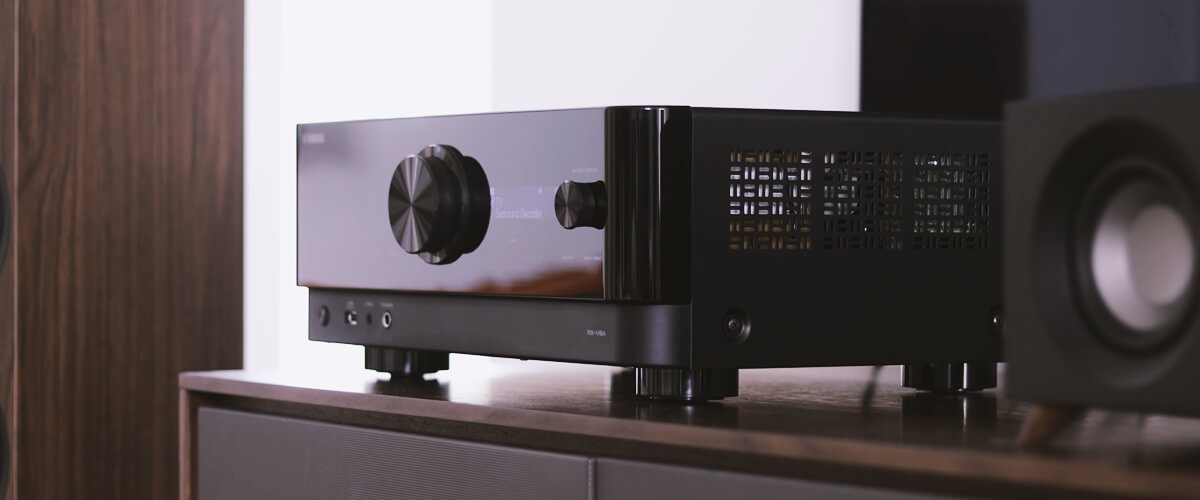
Here, I’ll describe some of the most common issues that users may face with their receivers and provide tips and solutions for addressing them.
- No sound or low volume: If you’re not getting any sound or the volume is too low, check that your speakers are properly connected to the receiver and that the receiver is set to the correct input. Make sure the volume is turned up and that any mute or low-volume settings are turned off. If you’re still not getting sound, try adjusting the speaker settings or running the receiver’s automatic calibration tool.
- Poor sound quality: There may be a problem with your speaker placement or the calibration settings. Check that your speakers are properly placed and that the calibration tool has been run. You may also need to adjust the EQ settings to achieve the desired sound quality.
- Connectivity issues: If you’re having trouble connecting your AV receiver to your other devices, check whether your cables are properly connected and your devices are set to the correct input. You may also need to update your firmware and drivers or adjust your network settings if you’re using a wireless connection.
- Overheating: Check if the receiver is properly ventilated and that there’s enough space around it for airflow. You may also need to adjust the fan settings or consider adding a fan or other cooling device.
- Remote control issues: Ensure the remote is properly paired with the receiver and the batteries are fully charged. You may also need to adjust the settings for the remote control in the receiver’s menu.
- HDMI issues: Try using a different HDMI cable or port. Plus, adjust the HDMI settings in the receiver’s menu or update the firmware.

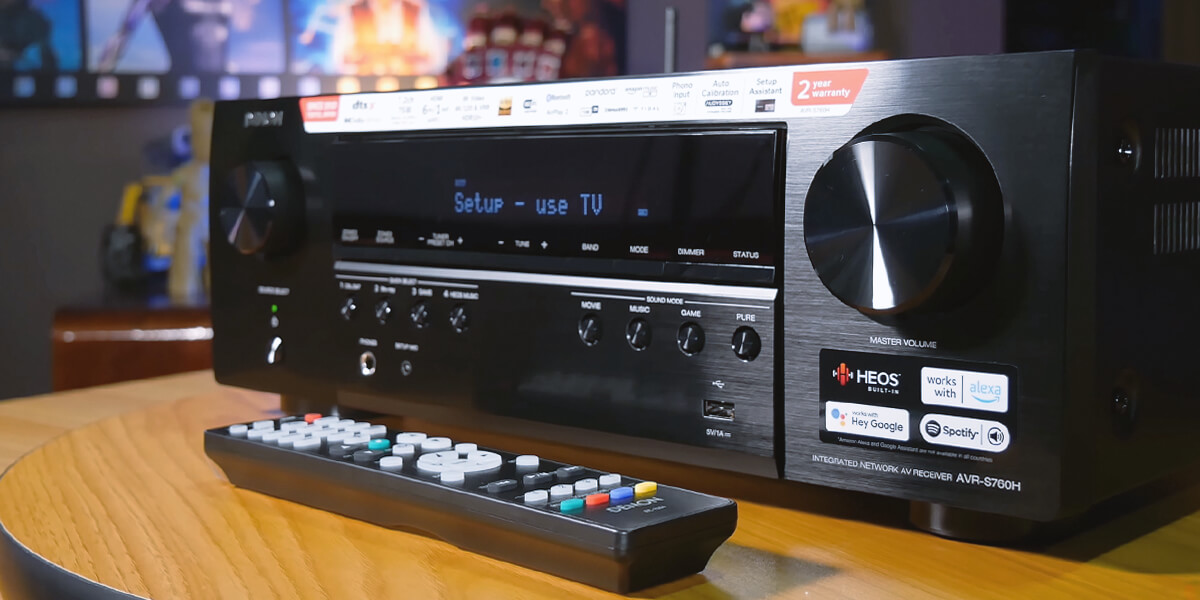


![Best 2-Channel Receiver [Expert Reviews and Buying Guide]](https://hometheaterology.com/wp-content/uploads/2023/11/best-2-channel-receiver-stereo-300x150.jpg)


